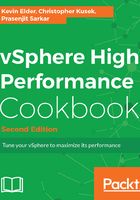
上QQ阅读APP看书,第一时间看更新
CPU performance best practices
CPU virtualization adds varying amounts of overhead. Because of this, you may need to fine-tune the CPU performance and need to know what the standard best practices are.
The following are the standard CPU performance best practices:
- You need to avoid using SMP VMs unless it is required by the application running inside the guest OS. This means if the application is not multithreaded, then there is no benefit of using the SMP VM.
- You should prioritize VM CPU usage with a proportional share algorithm.
- Use Distributed Resource Scheduler (DRS) and vMotion to redistribute VMs and reduce contention.
- Use the latest available virtual hardware for the VMs.
- Reduce the number of VMs running on a single host. This way, you can not only reduce contention, but also reduce the fault domain configuration.
- You should leverage the application-tuning guide from the vendor to tune your VMs for best performance.